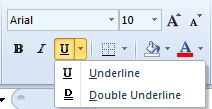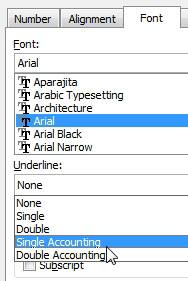Problem: My Manager wants tiny blank columns between the columns.
Strategy: Plan on restating your numbers to the Securities and Exchange Commission. Tiny blank columns are a recipe for disaster. Someone will sort part of the data and not all of the data.
Most managers who demand this are doing it to make the bottom border under the headings look better.

-
Tiny blank columns are dangerous.
The manager here is using a bottom border to create the lines under the headings. He ends up using the bottom border because underlines just don't look right. They only extend as long as the heading.

- Underlines rarely make the manager happy.
There is a solution that will make the manager happy. It won't be found in the ribbon. Remember that the options in the ribbon are there to make Excel novices happy. If you are reading this book, you frequently have to go beyond the ribbon. In the ribbon, they offer two types of underlines.

- Two underline types in the ribbon.
Skip the ribbon choices. Instead, click on the dialog launcher at the bottom of the Font group of the Home tab of the ribbon.

- Click the dialog launcher.
The underline dropdown in the Format Cells dialog offers four choices instead of two. Choose Single Accounting underline.

- The good choices are not in the ribbon.
The result are bottom underlines that extend almost all the way across the cell, but not quite all the way. When printed, this will give the same look as back in Fig 612.

- These underlines appear similar to gaps between columns.
Alternate Strategy: If your manager still demands the blank columns, you can put a word, just as "blank" in the headings of the blank columns. Change the font color to white to no one sees those headings when printed. This will allow the entire data set to be treated as a contiguous column.

